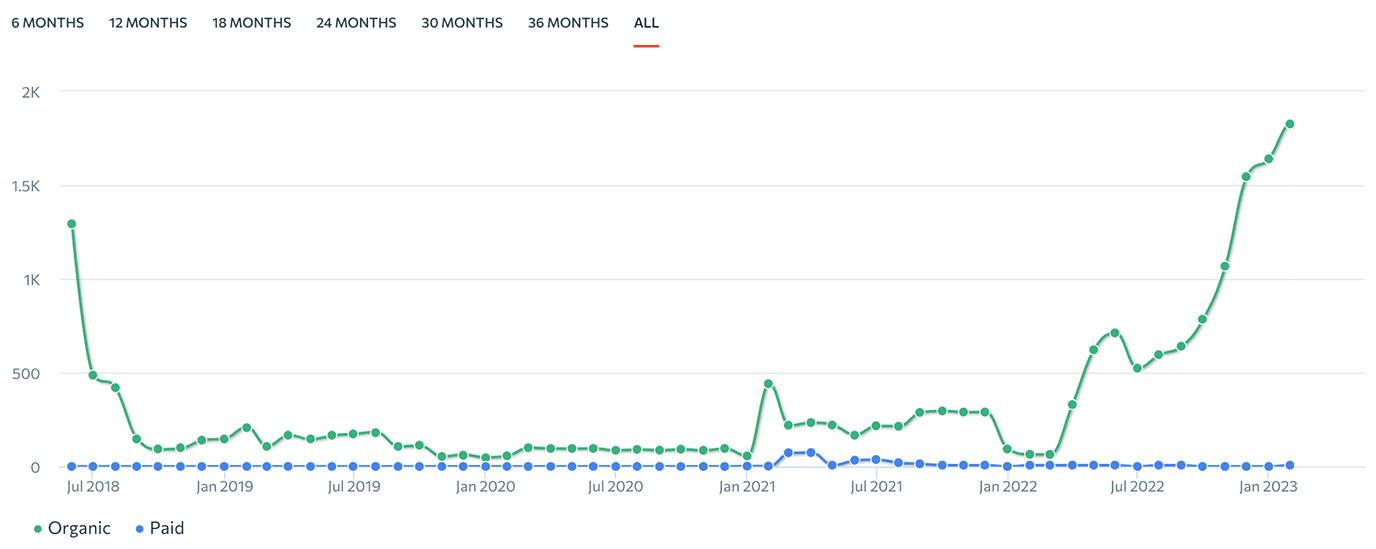THE Easiest Way to Grow Your Business: Translations

Vivian
Nov 5, 2024 • 12 min read
Translating your content is the easiest way to grow. Modern solutions makes it simple, fast, and cost-effective. 84% of marketers report revenue increase.

Unlocking Revenue Growth Through Translation
Did you know that 84% of marketers report that content localization directly contributes to revenue growth? Yet, many businesses overlook translation as a strategic growth tool, assuming it requires significant effort and cost. This misconception leads countless companies to miss out on one of the most straightforward ways to expand their market presence and increase revenue.
Research consistently shows that translating and localizing marketing content significantly boosts conversion rates, expands audience reach, and enhances customer engagement. From global enterprises to emerging startups, businesses that prioritize translation have reaped substantial benefits. Even better, the process of translating content has never been easier or more cost-effective, thanks to modern advancements in technology.
In this blog post, we’ll explore powerful data, real-world examples, and recent studies that illustrate why translating your marketing content is one of the most efficient ways to drive growth. You’ll gain insight into how companies leverage this strategy to tap into new markets and why adopting it could be a game-changer for your company.
Key Takeaways
- Translation is a Proven Growth Strategy: Evidence shows that translating and localizing content drives revenue growth.
- Modern Solutions Simplify Translation: Advancements in large language models (LLMs) and AI-driven tools make translation faster, more accurate, and significantly more cost-effective than traditional methods.
- Myths Debunked: Concerns about time, cost, and quality are outdated. Today's automated tools not only streamline the translation process but also ensure that brand voice and SEO strategies are maintained or even enhanced.
- Real-World Success Stories: Companies in industries from SaaS to e-commerce have seen double-digit increases in traffic and conversions through effective translation strategies.
- Practical Implementation Matters: Effective translation strategies include localized SEO, continuous content updates, and the use of context-aware technology to maintain brand consistency and maximize global reach.
Skip the Read, Start Translating Now
Don’t have time to read the whole post? No problem! Start boosting your business with seamless translation today and see the difference for yourself.
The Science Behind Translation and Growth
The data supporting the impact of translation on business growth is compelling and well-documented. Studies over the past few years have highlighted that translating and localizing content is a powerful tool for boosting engagement, conversion rates, and revenue.

This reinforces the idea that localization isn’t just an added expense but a proven investment that drives financial returns. In fact, businesses that prioritized localization were 1.5 times more likely to report increased revenue compared to those that did not.
The power of localization extends beyond website content to areas such as mobile advertising and social media performance. According to Avensia (2022), creating localized social media content led to an astonishing 4100% improvement in engagement. Similarly, Adparlor's research (2017) revealed that localized ads achieved a 22% higher conversion rate and up to an 87% increase in click-through rates for targeted demographics. These statistics showcase how translating content into a user’s native language can significantly amplify marketing efforts across multiple channels.
The benefits are not limited to marketing campaigns. An in-depth survey by Flow (2019) found that 67% of online consumers prefer seeing product descriptions in their native language, 63% prefer product reviews in their language, and 62% want the checkout process to be translated. This preference leads directly to higher trust, better user experience, and ultimately, more sales. Additionally, a DeepL survey (2024) found that 96% of companies investing in localization reported a positive return on investment (ROI), with 65% experiencing an ROI of three times or more.
These results make it clear that translating content is one of the most effective ways to foster international growth and strengthen a brand’s presence across new markets. The consistent, data-backed relationship between localized content and increased engagement serves as a testament to its importance in modern marketing strategies.
Debunking the Myths: Why Translation is Easier Than You Think
Despite the clear advantages, many marketing and product teams shy away from investing in translation due to misconceptions about the effort, cost, and complexity involved. However, the reality is that modern advancements in technology have made the translation process more accessible, efficient, and cost-effective than ever before.

Myth 1: Translation Takes Too Much Time and Resources
For decades, traditional translation pipelines were complex, involving extensive back-and-forth coordination with human translators and requiring a structured workflow to manage the translation process. Companies often faced long turnaround times and significant resource allocation to handle these manual translation efforts.
However, with the advent of large language models (LLMs) and other generative AI technologies, translation has become almost instantaneous. These tools have transformed translation from a drawn-out, multi-step process to a streamlined, automated workflow that teams hardly need to think about. Companies can now integrate advanced language models into their content pipeline, allowing seamless multilingual content creation without bottlenecks. This shift not only expedites the process but also maintains high quality, making translation a simple, scalable part of content strategy.
Myth 2: Translation is Expensive
Cost is another common barrier that prevents businesses from tapping into the potential of multilingual content. In the past, traditional translation methods could be costly, with rates often ranging between 20 to 30 cents per word, making large-scale translation projects a significant financial burden. However, leveraging technology-driven solutions has drastically reduced these expenses—by as much as 1400%. This dramatic drop in costs has made comprehensive localization efforts far more accessible and practical.
Tools like AI-assisted platforms offer scalable translation options that don't sacrifice contextual accuracy or cultural nuances, which were previously achievable only through human translators. This shift has allowed even smaller businesses to undertake comprehensive localization without significant financial strain.
A 2024 survey by Lokalise found that 88% of companies were either actively localizing their products or planning to do so within the next 18 months, largely due to the affordability and improved efficiency of modern translation tools. This innovation in cost-effective translation has democratized access, making high-quality localization feasible for companies of all sizes.
Use a Seamless Translation Process
Worried about costs and complexity? Frenglish makes high-quality, budget-friendly localization achievable to ensure you meet your goals and needs.
Myth 3: Machine Translations Sacrifice Quality for Speed
A common belief is that machine translations prioritize speed at the expense of quality, making them unsuitable for preserving a brand’s unique tone or handling the complexities of SEO. However, modern translation solutions like Frenglish have redefined this by leveraging large language models (LLMs) combined with AI-enhanced translation stacks. These tools ensure translated content accurately reflects brand voice and adapts to the latest SEO trends in different regions and languages.
Unlike human translators, who may not always possess the technical expertise or current SEO knowledge needed for different markets, advanced AI solutions can access real-time data and integrate regional SEO practices. This results in content that not only preserves a brand’s identity but also performs optimally in search rankings globally.
With context-aware technology, businesses can provide detailed brand guidelines, ensuring that AI-driven translations are tailored to maintain brand integrity. The result is a high-quality, consistent output that exceeds the capabilities of human translation by integrating technical nuances and up-to-date SEO requirements seamlessly.
The Reality: Translation Has Never Been Simpler. Today's technology has transformed translation from a complex, resource-heavy task into a seamless part of the content creation process. Whether it's websites, apps, blog posts, or social media campaigns, teams can now translate large volumes of content efficiently. The simplicity of these tools means that with just a few adjustments, companies can set up a translation pipeline and begin reaping the benefits of localized content almost immediately.
Companies across industries have demonstrated that embracing translation is a smart, achievable strategy that can unlock significant growth. The accessibility and precision of modern tools prove that this process is no longer reserved for large corporations but is scalable to meet the needs of businesses of all sizes.
Case Studies and Real-World Success Stories
While statistics and survey data provide compelling evidence, real-world examples further illustrate the transformative power of translation. Businesses across industries have successfully leveraged multilingual content strategies to drive significant growth, enhance engagement, and boost revenue.
1. UserGrowth's SEO Translation Case Study
A notable example is one of UserGrowth’s clients, a B2B SaaS provider, that faced challenges in ranking for key search terms across multiple languages. By conducting an SEO audit, performing targeted keyword research, and creating localized content briefings, the company optimized its English site and translated it into French, Dutch, and German. The result was a remarkable 2000% increase in organic traffic across these languages.

2. Revolut’s Multilingual Strategy Fuels Explosive Growth
In 2021, Revolut, a leading global financial superapp, attributed an impressive 186% growth in its user base to its strategic focus on multilingual content and localization. By translating its platform into multiple languages, Revolut was able to engage more effectively with users across different regions, enhancing accessibility and user experience. This comprehensive approach to localization not only drove user acquisition but also strengthened customer trust and loyalty in diverse markets. Revolut’s success underscores the substantial impact that investing in translation and localization can have on user growth and global expansion.

3. Increased Bookings in the Travel Industry
A travel service company, Welcome Pickups, restructured its translation process using advanced workflows. By implementing an automated solution, they saw a 66% increase in bookings through localized landing pages, contributing significantly to their annual revenue growth. This success story showcases how streamlined translation processes can drive customer engagement and growth in service-oriented sectors.
Tips for an Effective Translation Strategy
Building a translation strategy that drives growth and engagement requires more than just translating text word-for-word. Here are some practical tips to help marketing and product teams implement a successful translation approach that maintains brand integrity and maximizes impact:
1. Start with Market Research
Before investing in translation, conduct thorough research to identify key markets that align with your business goals. Understanding regional preferences, language nuances, and cultural differences is crucial for creating content that resonates with local audiences. This foundational step helps prioritize efforts and allocate resources efficiently.
2. Prioritize SEO Localization
Effective translation extends beyond words; it must account for search engine optimization. Ensure your translation strategy incorporates localized SEO, including keyword research for each target language and region. AI-driven tools and solutions like Frenglish can help adapt content to include trending search terms specific to each market, enhancing your visibility on local search engines.
3. Optimize for Generative Engine Optimization (GEOs)
As the adoption of large language models (LLMs) becomes more prevalent, companies must consider how to optimize their content for generative engines to maximize the effectiveness of their translation strategy. Generative Engine Optimization (GEOs) involves creating structured, context-rich content that LLMs can interpret, adapt, and localize effectively. This process ensures that the company's voice, message, and key information remain consistent across different markets. By incorporating clear source material, adding contextual metadata, and maintaining a unified tone, businesses can leverage GEOs to improve the accuracy and cultural relevance of their translations, ultimately enhancing global engagement and maintaining brand integrity.
4. Use Context-Aware Technology
Preserving your brand’s voice and tone across translations can be challenging. Utilizing translation platforms that incorporate context-aware AI ensures that your translated content maintains brand consistency. These tools can adapt to different formats—whether web pages, blog posts, or technical documentation—without losing the essence of your brand.
5. Implement Continuous Updates
SEO trends, consumer behavior, and language usage can change rapidly. Make translation a continuous process, with regular updates to your localized content to reflect the latest developments. This keeps your brand relevant and aligned with current consumer expectations, boosting engagement and maintaining competitive search rankings.
6. Leverage a Translation Platform with Integrated AI
Select a translation solution that integrates large language models (LLMs) and AI-powered workflows. This ensures translations are not only accurate but also optimized for industry-specific jargon, technical content, and current trends in SEO. Automated solutions like Frenglish streamline the process, allowing your team to focus on content creation while leaving localization to advanced technology.
7. Incorporate Feedback from Local Teams
If your company has teams in the target markets, gather feedback on translated content to fine-tune your localization strategy. Local teams provide insights that AI alone might not capture, such as subtle cultural nuances or regional dialects, adding another layer of authenticity to your content.
8. Test and Analyze Performance
Measure the effectiveness of your translated content by tracking key performance indicators (KPIs) such as traffic, conversion rates, and engagement metrics. Use these insights to adjust your approach as needed, ensuring your translation strategy supports broader business goals and continuously contributes to growth.
By incorporating these tips, businesses can build a robust translation strategy that aligns with their brand’s voice, maximizes SEO potential, and maintains relevance in diverse markets. However, handling all these elements in-house can be time-consuming and complex. That's where modern translation solutions come in.
Leave the Hard Work to Frenglish
Frenglish takes care of everything—from SEO localization and continuous updates to context-aware translation. Translate your content in minutes.
Conclusion: Embrace the Power of Translation for Growth
Translating and localizing your content is no longer just an optional strategy for forward-thinking businesses—it’s a proven necessity for sustainable growth. From increasing engagement and conversion rates to expanding market reach and boosting revenue, the benefits of translating content are clear. Backed by compelling data, real-world case studies, and modern technological advancements, translation has evolved from being a complex, costly endeavor to an accessible, automated, and high-return investment.
Embracing translation allows your brand to break language barriers, resonate with diverse audiences, and compete effectively in the global market. With solutions like Frenglish, achieving this level of reach has never been simpler. Advanced translation platforms handle the technical nuances, maintain your brand’s voice, and incorporate up-to-date SEO strategies to ensure your content performs at its best in any market.
Ready to take the next step? Start integrating translation into your growth strategy today and unlock the full potential of your brand.
Take the First Step Towards Effortless Translation
With Frenglish, translating your content has never been easier. From websites and blog posts to apps and marketing campaigns, Frenglish delivers seamless, high-quality translations that maintain your brand's voice and optimize SEO for global reach. Simplify your translation process and experience the benefits of engaging audiences worldwide.
Continue reading by signing up (it's free!)
Get full access to all our blogs to help you generate revenue
Already have an account?

Vivian
Founder
Vivian is the founder of Frenglish, driven by her passion for technology and product development. Before starting Frenglish, she worked as a product manager and software engineer, specializing in automation and robotics solutions. Throughout her career, she collaborated with prominent clients like Tesla, SpaceX, Google, Amazon, Disney, and others.